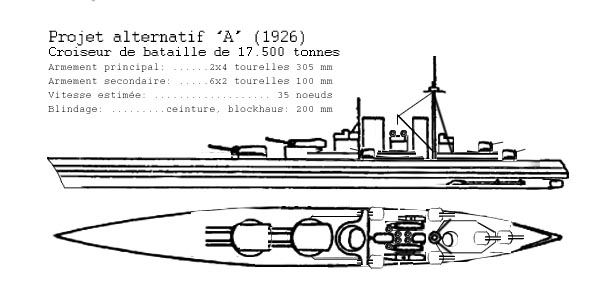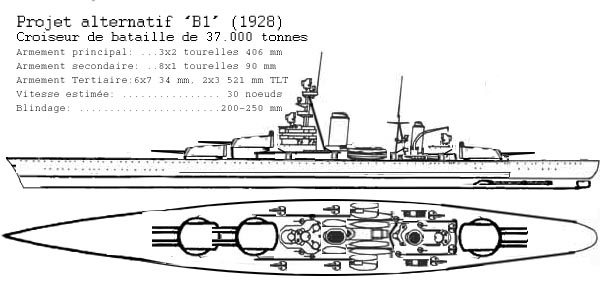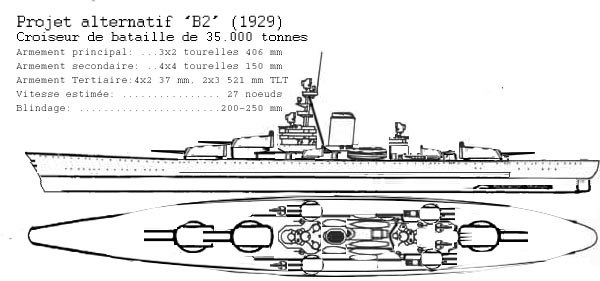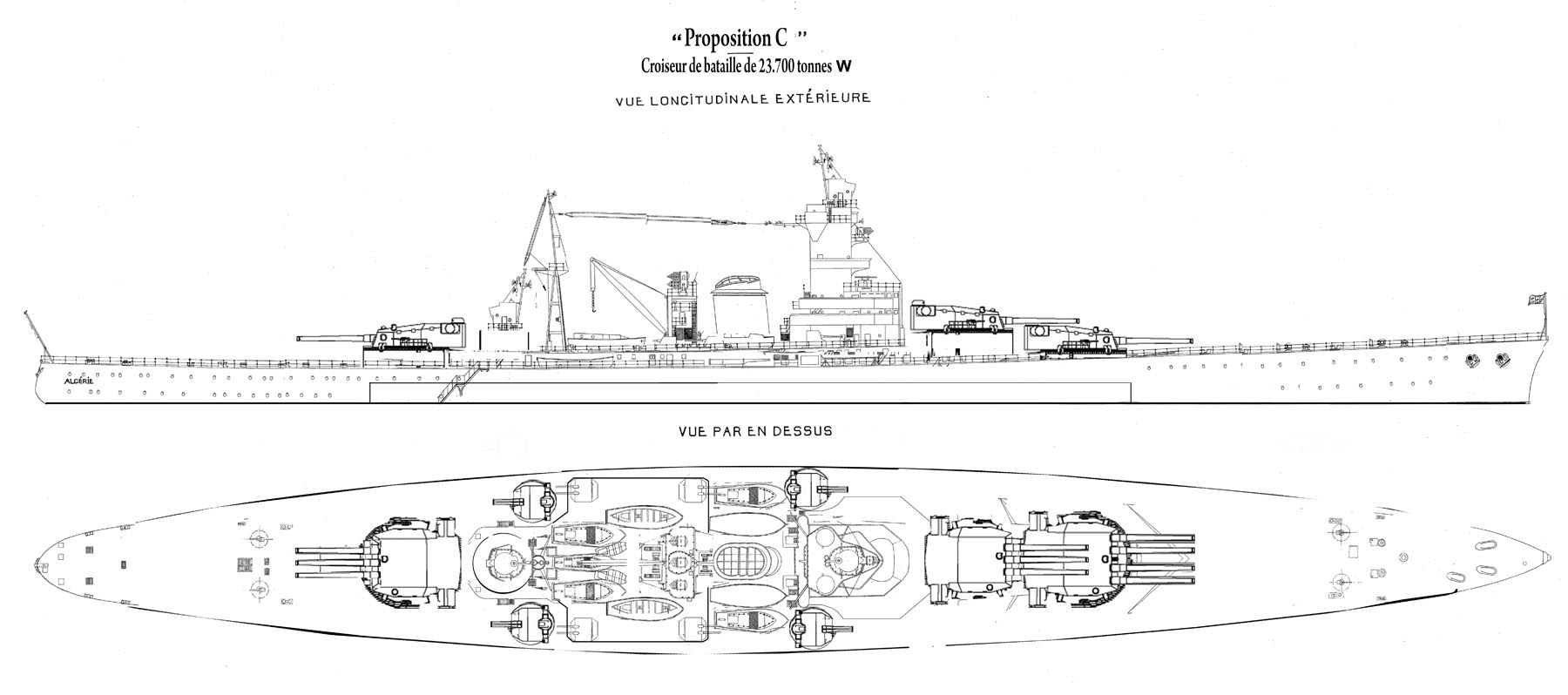stevep
Fleet admiral
Posts: 24,832 
Likes: 13,222
|
Post by stevep on Oct 22, 2021 12:41:02 GMT
Nice 1bigrich , some good designs. Did find on the Alsace-class battleship Wikipedia article, this sketches of the Alsace class. The Richelieu is at the top for comparison. The second of the three sketches of the Alsace class corresponds to type n ° 3 indicated by John Jordan and Robert Dumas. 
That would have been a potentially formidable design although according to the article it was the option least likely to be accepted as it would have required developing an entirely new gun in the midst of a war. They suggest either the 9x15" or the 12x15" - actually 380mm which is 15.1" of course as the French were using metric. Not sure, even if France survived a 1940 attack that they would have had the resources for any Alsace to be constructed during the war as air and land forces would have a much higher priority.
|
|
nicksumner
Petty Officer 1st Class
Posts: 98
Likes: 170
|
Post by nicksumner on Oct 22, 2021 19:37:40 GMT
If I may, I'm going to post a few Photoshopped pictures of French warships that never graced the seas in OTL but sail in the Drake's Drum timeline. As you may know, there's a separate thread in the Writer's hub concerning Drake's Drum, but none of the picture's I'm going to post here have been posted in that thread, so here goes. First up the battle cruiser Liberté on her builders trials 1931. This ship is based on the OTL Croiser de Bataille design studies of 1926-28. This image is photoshopped. Second the battleship Charlemagne complete with Spanish Civil War Neutrality Patrol markings. This ship is based on the OTL C1 design study of the French 1938 BIS program with a few modifications. This image is photoshopped.
Finally, the battleship Richelieu, incomplete, but running builder’s trials the day before the armistice of 1940. This ship is based on the OTL Project Type 2 and Type 3 design studies of 1939-40 with a few modifications. This image is photoshopped. To find out more about these designs I strongly recommend John Jordan and Robert Dumas' 'French Battleships 1922-54. To find out why French naval programs and the vessels they produce in the Drake's Drum timeline are so different from OTL feel free to visit my website where there is an Appendix on the Marine National.
|
|
lordroel
Administrator
Posts: 67,964 
Likes: 49,369
|
Post by lordroel on Oct 22, 2021 19:49:56 GMT
If I may, I'm going to post a few Photoshopped pictures of French warships that never graced the seas in OTL but sail in the Drake's Drum timeline. As you may know, there's a separate thread in the Writer's hub concerning Drake's Drum, but none of the picture's I'm going to post here have been posted in that thread, so here goes. First up the battle cruiser Liberté on her builders trials 1931. This ship is based on the OTL Croiser de Bataille design studies of 1926-28. This image is photoshopped. Second the battleship Charlemagne complete with Spanish Civil War Neutrality Patrol markings. This ship is based on the OTL C1 design study of the French 1938 BIS program with a few modifications. This image is photoshopped.
Finally, the battleship Richelieu, incomplete, but running builder’s trials the day before the armistice of 1940. This ship is based on the OTL Project Type 2 and Type 3 design studies of 1939-40 with a few modifications. This image is photoshopped. To find out more about these designs I strongly recommend John Jordan and Robert Dumas' 'French Battleships 1922-54. To find out why French naval programs and the vessels they produce in the Drake's Drum timeline are so different from OTL feel free to visit my website where there is an Appendix on the Marine National.
Those ships looks awesome nicksumner , especially the battleship Charlemagne. |
|
1bigrich
Sub-lieutenant
Posts: 478
Likes: 611
|
Post by 1bigrich on Oct 22, 2021 22:37:33 GMT
Did find on the Alsace-class battleship Wikipedia article, this sketches of the Alsace class. The Richelieu is at the top for comparison. The second of the three sketches of the Alsace class corresponds to type n ° 3 indicated by John Jordan and Robert Dumas. 
I suspect the top and bottom 'Alsace' 12 x 15in in that image were created by modifying a Richelieu plan. The one in the middle is closer to historic, with the correct secondary layout.
Regards,
|
|
lordroel
Administrator
Posts: 67,964 
Likes: 49,369
|
Post by lordroel on Oct 23, 2021 9:13:16 GMT
Found this related on the Dunkerque class Battleships (1935): Design A: 17,500 tonnes pocket battlecruisers (1926)When in 1925 the Italians launched their Trento-class cruisers, French Vice Admiral Salaun considered the construction of 17,500 tons large cruiser, armed with two quadruple turrets with a seemingly obsolete caliber, 12 inches (305 mm) all forward. They would have been capable of 34 to 35 knots and with a partial armor able to defeat 8-in (200 mm) calibers shells (those of the Trento).  Design B1: 37,000 tonnes battlecruisers (1927) Design B1: 37,000 tonnes battlecruisers (1927)
Next, three 37,000-ton battlecruisers designs were drawn in 1927-1928. Blueprints showed a very enlarged Suffren-class cruiser at 254-metre (833 ft) long, with the same tripod foremast but three quadruple 305 mm turrets, two forward, one aft and eight single 90 mm Mle 1926 HA guns, plus 37 mm AA mounts and torpedo tubes, 220 to 280 mm armour and 33 knots. The story of the croiseurs de bataille de 37,000 tonnes is convoluted: In 1927-28 Vice-Admiral Violette was Chief of General Staff of the Navy, and launched studies for capital ships, and specifically "battle cruisers of 37,000 tonnes". 35,000 tonnes was considered a "normal" displacement, 37,000 tonnes fully loaded versus the "standard" as defined by the Washington Treaty, of 32-33,000 tonnes. Blueprints showed a silhouette inspired by the Suffren class cruisers wit two raked funnels and three turrets, including two superimposed at the front, one aft, and a secondary artillery of 130 mm quadruple turrets. Heavy AA comprised single shielded 90 mm guns M1926 as used on Colbert and Foch. They had two side catapults an single crane between the funnel and a hangar for four seaplanes total. The design has many similarities with the future Dunkerque. Two types were designed in fact: -The 1927-28 design had twelve 305 mm guns in three quadruple turrets, twelve 130 mm guns. The latter were forward, abreast and behind the forward main artillery turrets, a third superimposed over "Z" main artillery turret aft, eight 90 mm, twelve 37 mm AA, 2x3 TT. Protection ranged from 220 to 280 mm, with 75 mm deck and ASW compartimentation with 20-50 mm sandwiched layers, coal and oil tanks and void ones, similar to the heavy cruisers plus machine compartimentation as the Duquesne class in separated groups. A top speed of 33 knots was planned and the hull was to be 254 m long. -The second type of 1928, was more a battleship with three twin 406 mm turrets, four 130 mm quadruple turrets, lower propulsion for 27 knots, but better armour. Construction for both however was dropped at the time as beyond the capacity of existing shipyards. The largest at the time was the Salou basin in Brest, 200 m long. British shipyards were at the time large enough at 270 m, Germans one reached 290 m. Île-de-France (1927) was just constructed and measured 245 m long and this was not enough. For the planned Normandy, famous transatlantic of 313 m, Ateliers et Chantiers de la Loire, Penhoët was forced to built a new construction hold, hold n ° 1. but its construction was beyond the French Navy budget at that time, so the project was postponed, and relaunched later on more reasonable dimensions, with compromises.  Design B2: 35,000 tonnes battlecruisers (1928) Design B2: 35,000 tonnes battlecruisers (1928) The second, 1928 alternative design called for a capital ship armed with three twin 406 mm turrets and four quadruple 130 mm turrets which was more capable of dealing with other battleships. It was shorter at 235 metres but wider, armor was thicker but the powerplant was smaller, thus reducing the top speed to 27 knots. However the choice was easy to make as there was no dock large enough to build a 35,000-ton hull longer than 250 metres (820 ft) at that time. In fact building the required docks would have cost the same as the two battleships, just when more stringent naval restrictions were discussed. Design C: 23,700 tonnes light battlecruisers (1929)The last chapter of this development came when the new chief of staff of the Marine Nationale, Vice Admiral Violette, ordered the Service Technique des Constructions Navales to design a modern "armoured cruiser" of 23,690 tons, a ship with a triple and quadruple turrets forward and one triple aft, all armed with the same 12 in caliber but protected with 8 in plates only. They were to be also armed by four twin 138 mm turrets and eight twin 100 mm AA turrets for 29 knots, and a general appareance which recalled the Algérie. In fact the design had the most influence over the Dunkerque proper development. In Geneva, indeed, a Committee for Disarmament from the League of Nations planned a Washington treaty expansion into 1936, and United Kingdom strongly urged to cap displacement and maximum caliber to 25,000 tonnes and 305 mm for new capital ships. The French Government protested it needed larger ships and at that time pushed for larger designs, but the French Admiralty nevrthless, allowed to sturdy a contingency design to use the available tonnage, of 23,333 tonnes. Therefore a 23,690 tonnes "protected cruiser" was worked on by 1929. It was to have three 305 mm turrets, triple and quadruple and eight 138 mm guns, in twin half turrets as those of the Mogador class, and twin DP 100 mm (Algérie). With a sungle funnel and superstructures recalling the latter, it was closing on the silhouette of the Dunkirk.  |
|













